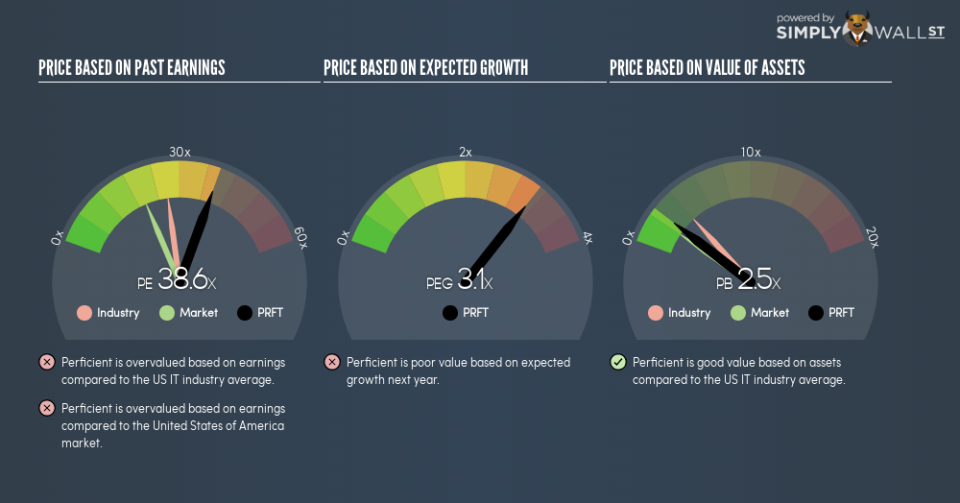Does Perficient Inc’s (NASDAQ:PRFT) PE Ratio Signal A Selling Opportunity?

The content of this article will benefit those of you who are starting to educate yourself about investing in the stock market and want to learn about the link between company’s fundamentals and stock market performance.
Perficient Inc (NASDAQ:PRFT) is trading with a trailing P/E of 38.6, which is higher than the industry average of 26.8. Though this might seem to be a negative, you might change your mind after I explain the assumptions behind the P/E ratio. In this article, I will break down what the P/E ratio is, how to interpret it and what to watch out for.
Check out our latest analysis for Perficient
What you need to know about the P/E ratio
The P/E ratio is one of many ratios used in relative valuation. It compares a stock’s price per share to the stock’s earnings per share. A more intuitive way of understanding the P/E ratio is to think of it as how much investors are paying for each dollar of the company’s earnings.
P/E Calculation for PRFT
Price-Earnings Ratio = Price per share ÷ Earnings per share
PRFT Price-Earnings Ratio = $28.5 ÷ $0.739 = 38.6x
The P/E ratio isn’t a metric you view in isolation and only becomes useful when you compare it against other similar companies. We want to compare the stock’s P/E ratio to the average of companies that have similar characteristics as PRFT, such as size and country of operation. A common peer group is companies that exist in the same industry, which is what I use. Since PRFT’s P/E of 38.6 is higher than its industry peers (26.8), it means that investors are paying more for each dollar of PRFT’s earnings. This multiple is a median of profitable companies of 25 IT companies in US including e-Synergies, Bitfarms Technologies and Fintech Select. You could think of it like this: the market is pricing PRFT as if it is a stronger company than the average of its industry group.
Assumptions to watch out for
Before you jump to conclusions it is important to realise that there are assumptions in this analysis. Firstly, that our peer group contains companies that are similar to PRFT. If this isn’t the case, the difference in P/E could be due to other factors. Take, for example, the scenario where Perficient Inc is growing profits more quickly than the average comparable company. In that case, the market may be correct to value it on a higher P/E ratio. We should also be aware that the stocks we are comparing to PRFT may not be fairly valued. So while we can reasonably surmise that it is optimistically valued relative to a peer group, it might be fairly valued, if the peer group is undervalued.
What this means for you:
Since you may have already conducted your due diligence on PRFT, the overvaluation of the stock may mean it is a good time to reduce your current holdings. But at the end of the day, keep in mind that relative valuation relies heavily on critical assumptions I’ve outlined above. Remember that basing your investment decision off one metric alone is certainly not sufficient. There are many things I have not taken into account in this article and the PE ratio is very one-dimensional. If you have not done so already, I highly recommend you to complete your research by taking a look at the following:
Future Outlook: What are well-informed industry analysts predicting for PRFT’s future growth? Take a look at our free research report of analyst consensus for PRFT’s outlook.
Past Track Record: Has PRFT been consistently performing well irrespective of the ups and downs in the market? Go into more detail in the past performance analysis and take a look at the free visual representations of PRFT’s historicals for more clarity.
Other High-Performing Stocks: Are there other stocks that provide better prospects with proven track records? Explore our free list of these great stocks here.
To help readers see past the short term volatility of the financial market, we aim to bring you a long-term focused research analysis purely driven by fundamental data. Note that our analysis does not factor in the latest price-sensitive company announcements.
The author is an independent contributor and at the time of publication had no position in the stocks mentioned. For errors that warrant correction please contact the editor at editorial-team@simplywallst.com.

 Yahoo Finance
Yahoo Finance 
